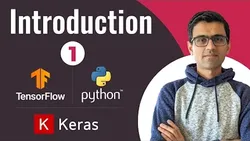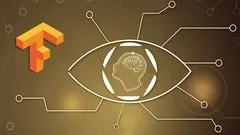
Learn TensorFlow and Deep Learning fundamentals with Python (code-first introduction) Part 1&2 
This course provides an introduction to TensorFlow and Deep Learning fundamentals with Python. It begins with an overview of what deep learning is and why it is used, followed by an explanation of neural networks. It then covers the basics of TensorFlow, including variables, constants, and placeholders. Finally, it provides an introduction to linear regression and how to use it with TensorFlow. ▼
ADVERTISEMENT
Course Feature
![]() Cost:
Cost:
Free
![]() Provider:
Provider:
Youtube
![]() Certificate:
Certificate:
Paid Certification
![]() Language:
Language:
English
![]() Start Date:
Start Date:
On-Demand
Course Overview
❗The content presented here is sourced directly from Youtube platform. For comprehensive course details, including enrollment information, simply click on the 'Go to class' link on our website.
Updated in [February 21st, 2023]
What does this course tell?
(Please note that the following overview content is from the original platform)
- Intro/hello/how to approach this video.
- MODULE 0 START (TensorFlow/deep learning fundamentals).
- [Keynote] 1. What is deep learning?.
- [Keynote] 2. Why use deep learning?.
- [Keynote] 3. What are neural networks?.
- [Keynote] 4. What is deep learning actually used for?.
- [Keynote] 5. What is and why use TensorFlow?.
- [Keynote] 6. What is a tensor?.
- [Keynote] 7. What we're going to cover.
- [Keynote] 8. How to approach this course.
- 9. Creating our first tensors with TensorFlow.
- 10. Creating tensors with tf Variable.
- 11. Creating random tensors.
- 12. Shuffling the order of tensors.
- 13. Creating tensors from NumPy arrays.
- 14. Getting information from our tensors.
- 15. Indexing and expanding tensors.
- 16. Manipulating tensors with basic operations.
- 17. Matrix multiplication part 1.
- 18. Matrix multiplication part 2.
- 19. Matrix multiplication part 3.
- 20. Changing the datatype of tensors.
- 21. Aggregating tensors.
- 22. Tensor troubleshooting.
- 23. Find the positional min and max of a tensor.
- 24. Squeezing a tensor.
- 25. One-hot encoding tensors.
- 26. Trying out more tensor math operations.
- 27. Using TensorFlow with NumPy.
- MODULE 1 START (neural network regression).
- [Keynote] 28. Intro to neural network regression with TensorFlow.
- [Keynote] 29. Inputs and outputs of a regression model.
- [Keynote] 30. Architecture of a neural network regression model.
- 31. Creating sample regression data.
- 32. Steps in modelling with TensorFlow.
- 33. Steps in improving a model part 1.
- 34. Steps in improving a model part 2.
- 35. Steps in improving a model part 3.
- 36. Evaluating a model part 1 ("visualize, visualize, visualize").
- 37. Evaluating a model part 2 (the 3 datasets).
- 38. Evaluating a model part 3 (model summary).
- 39. Evaluating a model part 4 (visualizing layers).
- 40. Evaluating a model part 5 (visualizing predictions).
- 41. Evaluating a model part 6 (regression evaluation metrics).
- 42. Evaluating a regression model part 7 (MAE).
- 43. Evaluating a regression model part 8 (MSE).
- 44. Modelling experiments part 1 (start with a simple model).
- 45. Modelling experiments part 2 (increasing complexity).
- 46. Comparing and tracking experiments.
- 47. Saving a model.
- 48. Loading a saved model.
- 49. Saving and downloading files from Google Colab.
- 50. Putting together what we've learned 1 (preparing a dataset).
- 51. Putting together what we've learned 2 (building a regression model).
- 52. Putting together what we've learned 3 (improving our regression model).
- [Code] 53. Preprocessing data 1 (concepts).
- [Code] 54. Preprocessing data 2 (normalizing data).
- [Code] 55. Preprocessing data 3 (fitting a model on normalized data).
- MODULE 2 START (neural network classification).
- [Keynote] 56. Introduction to neural network classification with TensorFlow.
- [Keynote] 57. Classification inputs and outputs.
- [Keynote] 58. Classification input and output tensor shapes.
- [Keynote] 59. Typical architecture of a classification model.
- 60. Creating and viewing classification data to model.
- 61. Checking the input and output shapes of our classification data.
- 62. Building a not very good classification model.
- 63. Trying to improve our not very good classification model.
- 64. Creating a function to visualize our model's not so good predictions.
- 65. Making our poor classification model work for a regression dataset.
We consider the value of this course from multiple aspects, and finally summarize it for you from three aspects: personal skills, career development, and further study:
(Kindly be aware that our content is optimized by AI tools while also undergoing moderation carefully from our editorial staff.)
This course provides a comprehensive introduction to TensorFlow and deep learning fundamentals. It covers topics such as the basics of deep learning, neural networks, and the practical applications of deep learning. Students will learn how to work with tensors, create and manipulate them using TensorFlow and NumPy, and perform operations like matrix multiplication and aggregation. The course also focuses on neural network regression, including model architecture, data preprocessing, model evaluation, and techniques for improving regression models. Additionally, it explores neural network classification, covering inputs, outputs, tensor shapes, and the typical architecture of classification models. Throughout the course, students will gain hands-on experience through practical exercises and learn essential skills to develop and evaluate deep learning models using TensorFlow.
[Applications]
After completing this course, learners should be able to apply the knowledge they have gained to create and evaluate their own TensorFlow and Deep Learning models. They should be able to use the code-first introduction to TensorFlow and Deep Learning fundamentals with Python to create tensors, manipulate tensors, and create neural network regression and classification models. Learners should also be able to use the techniques they have learned to preprocess data, evaluate models, and save and load models.
[Career Paths]
Three recommended career paths for learners of this course are:
1. Deep Learning Engineer: Deep Learning Engineers are responsible for designing, developing, and deploying deep learning models. They must have a strong understanding of the fundamentals of deep learning, including neural networks, TensorFlow, and Python. They must also be able to develop and optimize models for various applications, such as natural language processing, computer vision, and robotics. The demand for Deep Learning Engineers is growing rapidly, as more companies are looking to leverage the power of deep learning to improve their products and services.
2. Machine Learning Engineer: Machine Learning Engineers are responsible for designing, developing, and deploying machine learning models. They must have a strong understanding of the fundamentals of machine learning, including supervised and unsupervised learning, data preprocessing, and model optimization. They must also be able to develop and optimize models for various applications, such as natural language processing, computer vision, and robotics.
3. Data Scientist: Data Scientists are responsible for analyzing large datasets to uncover insights and trends. They must have a strong understanding of data analysis techniques, including data mining, data visualization, and predictive analytics.
Course Provider

Provider Youtube's Stats at AZClass
Over 100+ Best Educational YouTube Channels in 2023.
Best educational YouTube channels for college students, including Crash Course, Khan Academy, etc.
AZ Class hope that this free Youtube course can help your Tensorflow skills no matter in career or in further education. Even if you are only slightly interested, you can take Learn TensorFlow and Deep Learning fundamentals with Python (code-first introduction) Part 1&2 course with confidence!
Discussion and Reviews
0.0 (Based on 0 reviews)
Explore Similar Online Courses

Biostatistics Mini-Lectures

Required & Core Practicals for the 9-1 GCSE Science

Deep Learning With Tensorflow 20 Keras and Python

Tensorflow on Googles Cloud Platform for Data Engineers

Deep Learning and Reinforcement Learning with Tensorflow

Tensorflow Deep Learning - Data Science in Python

Neural Networks with Tensorflow

TensorFlow Hub: Deep Learning Computer Vision and NLP

LEARNING PATH: TensorFlow: Computer Vision with TensorFlow

Hands-On Transfer Learning with TensorFlow 20

Human Tracking & Counting using TensorFlow & Deep Learning


Start your review of Learn TensorFlow and Deep Learning fundamentals with Python (code-first introduction) Part 1&2